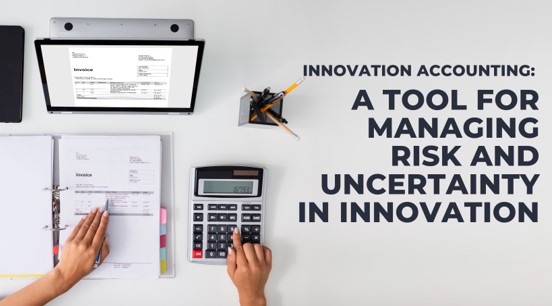Innovation Accounting: A Tool For Managing Risk And Uncertainty In Innovation

When it comes to innovation, it’s crucial not only to forecast and predict the future but also to manage risk and uncertainty. One way to do this is through accounting techniques that can help you manage risk by clearly showing how much funding you need, how best to spend your resources, and how much money you’ll have left over after your project is complete. This practice is known as innovation accounting, and it can help you stay on track when tackling complex tasks. By utilizing this tool, you’ll be better prepared to identify, measure and manage the risks associated with your innovation projects.
With innovation accounting, you can access an up-to-date snapshot of your finances and make informed decisions that will benefit your project. By taking a proactive approach to measuring and managing risk, you can ensure success in your innovative endeavors.
Let’s take a closer look at how innovation accounting works and what it can do for you.
The Problem With Typical Project Management
Traditional project management is too rigid. It’s difficult to make changes, and it doesn’t allow for flexibility or account for uncertainty. That’s why innovation accounting has emerged as a tool to help manage risk and uncertainty in innovation.
What is innovation accounting? Innovation accounting is an approach that uses data-driven insights to measure progress and make decisions when innovating.
Innovation has unique challenges that require more than just the traditional approach. We need a better way of managing innovation projects, which allows us to manage risk, plan effectively, and make better decisions throughout the process.
Innovation Accounting In Practice
Innovation accounting helps you to:
- Understand the value of your ideas (and how they compare with others). Innovation accounting helps you make better decisions about which ideas to pursue, as well as how much effort should be invested in them.
- Identify opportunities for improvement. Innovation accounting can help identify areas where there’s room for improvement, whether it’s related directly to an existing project or something else entirely that would benefit from some attention. The process can also reveal strengths within your team, which will encourage them towards even greater success.
- Determine your opportunity cost. Innovation accounting can help you measure the value of pursuing an idea, as well as its costs. This information can be used to determine whether or not it’s worth investing time and money into a new venture.
Using Innovation Accounting To Measure And Manage Risk
Innovation accounting is a tool that allows you to measure and manage risk. It’s a way of quantifying the risks associated with your innovation.
When you’re working on an innovative product, many things can go wrong along the way. You might run into technical problems, financial challenges, or other issues that make it difficult to get your product into the market successfully. Innovation accounting helps you track all of these problems so that you can understand them better and develop solutions for them if necessary.
Innovation accounting uses three main tools:
- The first tool is a risk register – this is basically a list of all of your potential risks and challenges associated with your product development process. These risks should be described as precisely as possible so that they can be easily understood by everyone who reads them later on.
- The second tool is an impact analysis – this involves analyzing each risk by determining its probability of occurring based on history and data collected from similar projects over time. This tool can help you identify the most significant risks and how to address them.
- The third tool is an opportunity analysis – this involves identifying positive outcomes that might occur if the project were successful, even if those outcomes aren’t directly related to the product itself. This tool can help you identify areas of opportunity and prioritize development in those areas.
How to Estimate Uncertainty for Each Project Type?
Innovation accounting is beneficial for organizations that have several different types of projects, such as research and development (R&D) projects, product development projects, and service design projects.
When you’re managing innovation accounting, you need to estimate the uncertainty for each project type. There are three main ways to do this: qualitative assessment, quantitative analysis, and benchmarking.
- Qualitative assessment is when you use your judgment to assess a project’s uncertainty. This could be based on factors like whether it’s a first-of-its-kind project, how big of an impact it will have on the organization if it succeeds or fails, or how much money is being invested in it.
- Quantitative analysis is when you use data from previous projects, like cost overruns or schedule slippages, to predict how risky your new project might be. You can also use this approach for projects that are similar in scope to other projects that have already been completed.
- Benchmarking is when you look at another organization’s processes and performance metrics so that you can learn from their experience with risk assessment and management.
How Are Some Organizations Using Innovation Accounting Successfully Today?
Innovation accounting is being used by companies in a variety of ways to manage innovation-related risk and uncertainty better.
At one point, it was thought that innovation accounting would only be useful for new products, but this has not proven true. For example, an auto manufacturer has successfully used innovation accounting to record costs associated with developing a new engine for their hybrid cars. This allowed them to predict better the cost of producing their car and determine whether or not they could profit from it.
Another company used innovation accounting to monitor how much time each employee spent working on a specific project to determine who should be recognized for their contribution. This was beneficial because it allowed everyone on the team to know how much effort they had put into the project and how much recognition they deserved.
By tracking progress, measuring results, and identifying risk areas, organizations continue to reap the rewards of innovation accounting.
Innovation Accounting Is For Everyone
Innovation accounting is a way to think about your business model, plan new strategies and projects, and make decisions based on your assumptions.
This means it’s not just for the people working on the product – it’s for everyone. Innovation accounting can help you think about how your business operates as a whole and ensure you’re making the best decisions for the future. With it, you can better manage risk, increase your chances of success, and ensure that your innovation efforts are on the right track.
Additional:


























